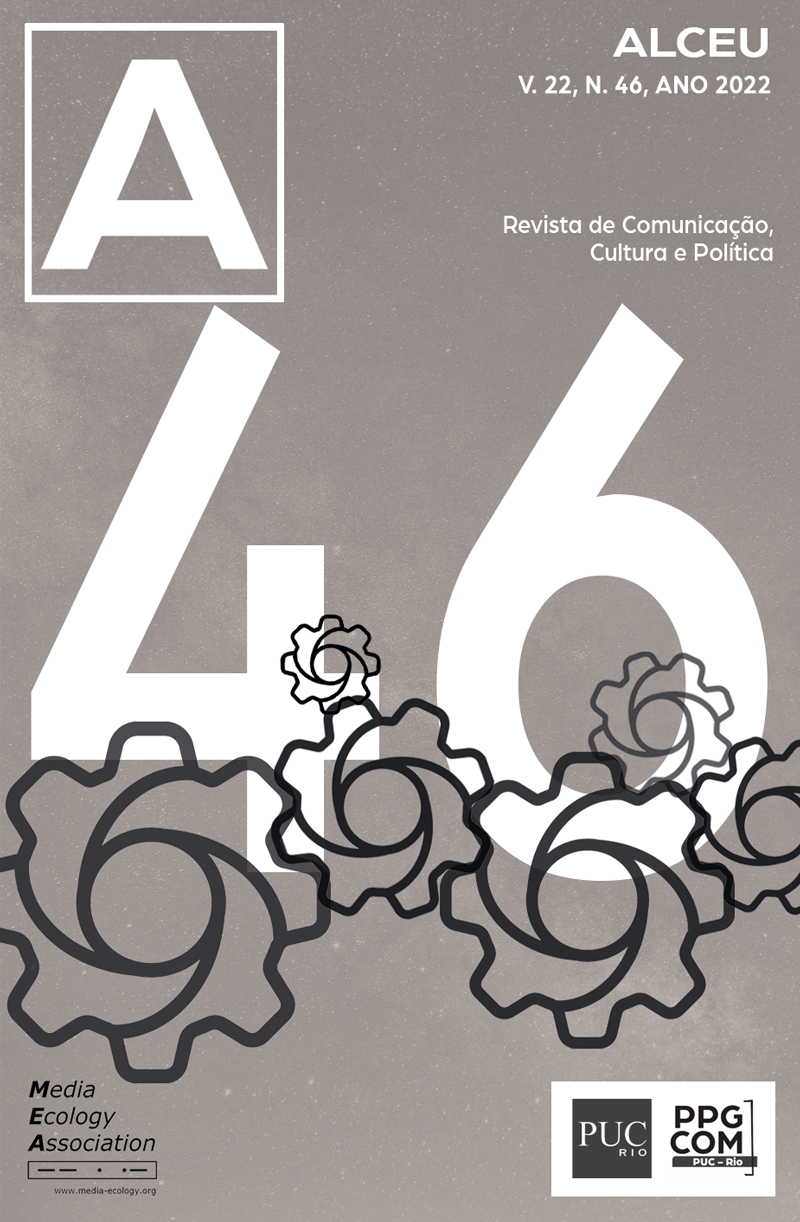Algorithmic mediation and the spiral of silence
Reconfigurations of the theory based on four analysis mechanisms
DOI:
https://doi.org/10.46391/ALCEU.v22.ed46.2022.199Keywords:
Journalism, Communication, Spiral of Silence, Algorithms, ReceptionAbstract
This paper deals with the reconfigurations of Noelle-Neumann's (2010) original theory and presents an analysis categorization for the contemporary spiral of silence, which involves four mechanisms: 1) accumulation; 2) consonance; 3) ubiquity; and 4) anonymity. In order to avoid excluding the term social and analyzing meanings and technologies separately, the results in this paper were presented from a sociocultural matrix reception study with eight unionized teachers and eight neo-Pentecostal evangelicals residing in the city of Curitiba (PR). Once determining that algorithms are relevant towards defining new cultural patterns of social interaction, we found the need to investigate consolidated theories in the field of communication and journalism in the light of algorithmic mediations.
Downloads
References
ALEXANDRE, José C. Uma genealogia da espiral do silêncio: a expressão da opinião sobre as práxis acadêmicas. Covilhã: Editora LabCom, 2018.
ANGELIS, Carlos de. La opinión pública entre la razón y el control social. Una actualización en la era del Big Data. AVATARES de la comunicación y la cultura, n. 11, junio de 2016.
BEER, David. Metric power. Londres: Palgrave Macmillan, 2016.
BELL, Emily; OWEN, Taylor. A imprensa nas plataformas: como o Vale do Silício reestruturou o jornalismo. Revista de Jornalismo ESPM, jul-dez de 2017, p. 48-83.
BUCHER, Taina. Programmed sociality: a software studies perspective on social networking sites. University of Oslo, 2012.
CAMPOS, João D. C. de. Uma eleição de ecos numa esfera pública digital polarizada: A comunicação política online nas eleições presidenciais norte-americanas de 2016. 2018. 61 f. Dissertação – Departamento de Sociologia e Políticas Públicas, Instituto Universitário de Lisboa.
CARIBÉ, João C. R. Algoritmização das relações sociais em rede, produção de crenças e construção da realidade. 2019. 166 f. Dissertação – Escola de Comunicação, Programa de Pós-Graduação em Ciência da Informação, Universidade Federal do Rio de Janeiro.
SPONHOLZ, Liriam; CHRISTOFOLETTI, Rogério. From preachers to comedians: Ideal types of hate speakers in Brazil. Global Media and Communication, December 23, 2018, p. 1-18, 2018.
COULDRY, Nick; HEPP, Andreas. A construção mediada da realidade. Editora: Unisinos, 2020.
D’ANDRÉA, Carlos F. de B. Pesquisando plataformas online: conceitos e métodos. Salvador: EDUFBA, 2020.
DOURISH, Paul. Algorithms and their others: algorithmic culture in context. Big Data & Society, v. 3, n. 2, 2016.
GASKELL, George. Entrevistas individuais e grupais. In: BAUER, Martin W.; GASKELL, George. Pesquisa qualitativa com texto, imagem e som: um manual prático. Petrópolis: Vozes, 2002. pp. 64-89.
GILLESPIE, Tarleton. The relevance of algorithms. In: GILLESPIE, Tarleton; BO-CZKOWSKI, Pablo J.; FOOT, Kirsten A. (org.). Media technologies: essays on communication, materiality, and society. Cambridge: MIT Press, 2014. p. 167-194.
HAMPTON, Keith; et al. Social Media and the ‘Spiral of Silence’. Pew Research Center. 26 ago. 2014.
ESCOSTEGUY, Ana C. Notas para um estado da arte sobre os estudos brasileiros de recepção nos anos 90. In: MACHADI, Juremir; LEMOS, André; SÁ, Simone Pereira de (org.) Mídia.Br. Porto Alegre: Sulina, 2004.
JUST, Natascha; LATZER, Michael. Governance by algorithms: reality construction by algorithmic selection on the Internet. Media, Culture & Society, v. 39, n. 2, p. 238-258, 2017.
LATZER, Michael; et al. The economics of algorithmic selection on the Internet. Working Paper – Media Change & Innovation Division. University of Zurich: Zurich, 2014.
LOPES, Maria I. V. de. A teoria barberiana da comunicação. MATRIZes, v. 12, n. 1, São Paulo, 2018.
MALASPINA, Cristina. The Spiral of Silence and Social Media: analysing Noelle-Neumann’s phenomenon application on the Web during the Italian Political Elections of 2013. 2014. 80 f. Dissertation. Department of Media and Communications: MSc in Media and Communications, London School of Economics and Political Science.
MARQUES, Claudio F. Esferas públicas, teorias de comunicação e hipóteses contemporâneas: traçando uma releitura. In: 42º CONGRESSO BRASILEIRO DE CIÊNCIAS DA COMUNICAÇÃO, Anais, Belém, Pará, 2 a 7 de setembro de 2019.
MARTÍN-BARBERO, Jesús. Dos meios às mediações. Rio de Janeiro: Editora UFRJ, 2015.
MARTINO, Luís M. S. Teorias da comunicação: ideias, conceitos e métodos. Petrópolis: Vozes, 2009.
MORENO, Alejandro; SIERRA, Eduardo. Capturando el silencio 2.0: el fenómeno spiral of silence en Facebook. Em Debate, Belo Horizonte, v. 8, n. 7, p. 48-72, dez. 2016.
MOURA, Zita Bacelar. Da mentira que se quer verdade: fake news, uma velha chaga em novos tempos. 2018. 93 f. Dissertação – Departamento de Filosofia, Comunicação e Informação, Mestrado em Jornalismo e Comunicação, Universidade de Coimbra.
NAPOLI, Philip M. The Algorithm as Institution: Toward a theoretical framework for automated media production and consumption. Fordham University Schools of Business Research Paper, 2013.
NOELLE-NEUMANN, Elisabeth. La espiral del silencio: opinión pública: nuestra piel social. Barcelona: Paidos Espanha, 2010.
PASQUALE, Frank. A Esfera pública automatizada. LÍBERO – Revista eletrônica do Programa de Mestrado em Comunicação da Faculdade Cásper Líbero, ano XX, n. 39, jan./ago., 2017.
PENA, Felipe. Teoria do jornalismo. São Paulo: Contexto, 2015.
POELL, Thomas; NIEBORG; David, VAN DIJCK, José. Platafomização. Fronteiras – estudos midiáticos, vol. 22, n. 1 - janeiro/abril, 2020.
PORTEN-CHEÉ, Pablo; EILDERS, Christiane. Spiral of silence on-line: How on-line communication affects opinion climate perception and opinion expression regarding the climate change debate. Studies in Communication Sciences, v. 15, n. 1, 2015, p. 143-150.
RIEDER, Bernard. Engines of Order – A Mechanology of Algorithmic Techniques. Amsterdam: Amsterdam University Press, 2020.
SCHULZ, Anne; ROESSLER, Patrick. The spiral of silence and the internet: selection of on-line content and the perception of the public opinion climate in computer-mediated communication environments. International Journal of Public Opinion Research, v. 24, n. 3, 2012.
SILVEIRA, Sergio A. da. Democracia e os códigos invisíveis. São Paulo: Edições SESC, 2019.
SRNICEK, Nick. Platform capitalism. Cambridge: Polity Press, 2017.
STOYCHEFF, Elizabeth. Under surveillance: examining Facebook’s spiral of silence effects in the wake of NSA Internet Monitoring. Journalism & Mass Communication Quarterly, 2016, p. 1-16.
THOMPSON, John B. The New Visibility. Theory, Culture & Society, v. 22, n. 6, 2005.
Downloads
Published
How to Cite
Issue
Section
License
Copyright (c) 2022 Revista ALCEU

This work is licensed under a Creative Commons Attribution-NonCommercial 4.0 International License.






